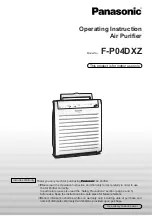
4 Installation
Installation manual
9
EWAQ+008BAVP
Packaged air-cooled water chillers and packaged air to water heat
pumps
4P478610-1 – 2017.02
NOTICE
Glycol absorbs water from its environment. Therefore do
NOT add glycol that has been exposed to air. Leaving the
cap off the glycol container causes the concentration of
water to increase. The glycol concentration is then lower
than assumed. As a result, the hydraulic components
might freeze up after all. Take preventive actions to ensure
a minimal exposure of the glycol to air.
NOTICE
▪ If overpressure occurs, the system will release some of
the liquid through the pressure relief valve. If glycol was
added to the system, take adequate measures so as to
safely recover it.
▪ In any case, make sure that the flexible hose of the
pressure relief valve is ALWAYS free to release
pressure. Prevent water from staying and/or freezing
up inside the hose.
WARNING
Due to presence of glycol, corrosion of the system is
possible. Uninhibited glycol will turn acidic under the
influence of oxygen. This process is accelerated by the
presence of copper and high temperatures. The acidic
uninhibited glycol attacks metal surfaces and forms
galvanic corrosion cells that cause severe damage to the
system. Therefore it is important that:
▪ the water treatment is correctly executed by a qualified
water specialist,
▪ a glycol with corrosion inhibitors is selected to
counteract acids formed by the oxidation of glycols,
▪ no automotive glycol is used because their corrosion
inhibitors have a limited lifetime and contain silicates
which can foul or plug the system,
▪ galvanized pipes are NOT used in glycol systems since
the presence may lead to the precipitation of certain
components in the glycol's corrosion inhibitor.
Adding glycol to the water circuit reduces the maximum allowed
water volume of the system. For more information, refer to the
chapter "To check the water volume and flow rate" in the installer
reference guide.
4.3.3
To fill the water circuit
1
Connect the water supply hose to the drain and fill valve.
2
Open the drain and fill valve.
3
If an automatic air purge valve was installed, make sure it is
open.
4
Fill the circuit with water until the manometer (field supply)
indicates a pressure of ±2.0 bar.
5
Purge as much air as possible from the water circuit. For
instructions, see
"6 Commissioning" on page 17
.
6
Refill the circuit until the pressure is ±2.0 bar.
7
Repeat steps 5 and 6 until no more air is purged and there are
no more pressure drops.
8
Close the drain and fill valve.
9
Disconnect the water supply hose from the drain and fill valve.
4.3.4
To insulate the water piping
The piping in the complete water circuit MUST be insulated to
prevent condensation during cooling operation and reduction of the
heating and cooling capacity.
To prevent the freezing of the outdoor water piping during winter
time, the thickness of the sealing material MUST be at least 13 mm
(with λ=0.039 W/mK).
If the temperature is higher than 30°C and the humidity is higher
than RH 80%, the thickness of the insulation materials should be at
least 20 mm to prevent condensation on the surface of the
insulation.
During winter, protect the water piping and shut‑off valves against
freezing by adding heat tape (field supply). If the outdoor
temperature can drop below –20°C and no heat tape is used, it is
recommended to install the shut‑off valves indoors.
4.4
Connecting the electrical wiring
DANGER: RISK OF ELECTROCUTION
WARNING
ALWAYS use multicore cable for power supply cables.
4.4.1
To connect the electrical wiring on the
outdoor unit
1
Remove the switch box cover. See
"4.1.1 To open the outdoor
unit" on page 6
.
2
Insert the wiring from the back of the unit:
a
b
c
≥25 mm
a
Low voltage cable
b
High voltage cable
c
Power supply cable
NOTICE
The distance between the high voltage and low voltage
cables should be at least 25 mm.










































